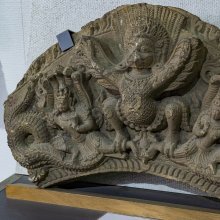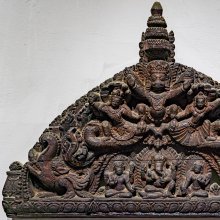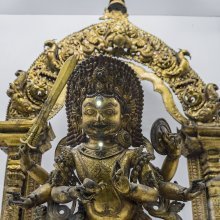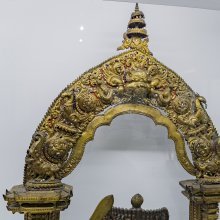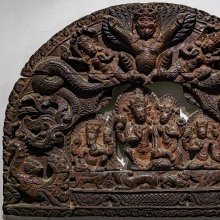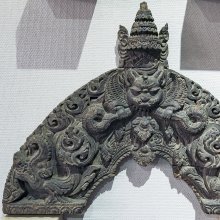Torana, Toraṇa: 31 definitions
Introduction:
Torana means something in Buddhism, Pali, Hinduism, Sanskrit, the history of ancient India, Marathi, Jainism, Prakrit, Hindi. If you want to know the exact meaning, history, etymology or English translation of this term then check out the descriptions on this page. Add your comment or reference to a book if you want to contribute to this summary article.
Alternative spellings of this word include Toran.
Images (photo gallery)
(+17 more images available)
In Hinduism
Vastushastra (architecture)
Source: archive.org: Catalogue of Pancaratra Agama Texts (vastu)Toraṇa (तोरण) refers to “arches”, as discussed in chapter 2 of the Viṣvaksenasaṃhitā: a Pāñcarātra text comprising 2800 Sanskrit verses dealing with theological matters, image-worship, iconography (relating to pratimā-icons) and the construction of temples.—Description of the chapter [maṇḍapādi-lakṣaṇa]: [...] Here the narrator promises to take up the rules for construction of maṇḍapa-pavilions, kuṇḍa-firepits, sruk and sruva ladles, toraṇa-arches and how to do worship to all of these with the various dvārapālaka-guardians. [...] Turning to the subsidiary paraphernalia, he points out that the measurements of the ladles and other instruments and decorations are to be proportionate to the size of the firepits, as are also the subsidiary toraṇa-arches that are to be built as part of the whole construction. [...]
Source: Shodhganga: Temples of Salem region Up to 1336 ADToraṇa (तोरण) means an “ornamental canopy set at the entrance”. The entrance may be to a courtyard or an enclosure or hall or maṇḍapa or a cellar or a Niche. The concept of toraṇa is seen as early as the beginning of the Christian era. Toraṇa consists of two vertical posts installed at a distance, supporting a decorated canopy above. This architectural model is used as a decorative motif on the walls of the temple, toraṇas are also carved to precede the koṣṭhas on the walls.
Source: OpenEdition books: Architectural terms contained in Ajitāgama and RauravāgamaToraṇa (तोरण) refers to “- 1. arcature §§ 3.34, 44, 45; 4.10, 22, 28; 5.8 - 2. portal frame (for a swing) (Aj) § 4.31.”.—(For paragraphs cf. Les enseignements architecturaux de l'Ajitāgama et du Rauravāgama by Bruno Dagens)

Vastushastra (वास्तुशास्त्र, vāstuśāstra) refers to the ancient Indian science (shastra) of architecture (vastu), dealing with topics such architecture, sculpture, town-building, fort building and various other constructions. Vastu also deals with the philosophy of the architectural relation with the cosmic universe.
Shaktism (Shakta philosophy)
Source: Google Books: ManthanabhairavatantramToraṇa (तोरण) refers to “mansions”, according to the Ṣaṭsāhasrasaṃhitā, an expansion of the Kubjikāmatatantra: the earliest popular and most authoritative Tantra of the Kubjikā cult.—Accordingly, “[...] O goddess, I will (now) tell you about the god of Kāmarūpa. (His) city is fashioned all around with pillars of sapphire. It has palaces, mansions, arches, banners, goads, and bows [i.e., prāsāda-toraṇa-aṭṭāla-dhvaja-aṅkuśa-dhanus-dhara]. The god holds five arrows and is accompanied by Kāmeśvarī. Without a body and in the form of light, he melts away the entire universe. He is the lord of the fourteen worlds and holds the staff (of authority). Everything, including passion and the rest, takes place impelled by his will. Thus, it is located in the foremost portion, above Mind Beyond Mind. O Pārvatī, one should meditate on it above the Cavity of Brahmā within the End of the Twelve”.

Shakta (शाक्त, śākta) or Shaktism (śāktism) represents a tradition of Hinduism where the Goddess (Devi) is revered and worshipped. Shakta literature includes a range of scriptures, including various Agamas and Tantras, although its roots may be traced back to the Vedas.
Jyotisha (astronomy and astrology)
Source: Wisdom Library: Brihat Samhita by VarahamihiraToraṇa (तोरण) refers to a “gate”, according to the Bṛhatsaṃhitā (chapter 3), an encyclopedic Sanskrit work written by Varāhamihira mainly focusing on the science of ancient Indian astronomy astronomy (Jyotiṣa).—Accordingly, “If the sun should appear like a pot; he brings on hunger and death; if he should appear broken, the reigning prince dies; if without rays, mankind will be afflicted with fears; if like a gate [i.e., toraṇa-rūpa], then the capital city, if like an umbrella then the country, will perish. If the sun should appear like a flag staff, or a bow, or quivering or of sharp rays he will bring on wars; if there should appear black lines on his disc the reigning prince will die by the hand of his own minister”.

Jyotisha (ज्योतिष, jyotiṣa or jyotish) refers to ‘astronomy’ or “Vedic astrology” and represents the fifth of the six Vedangas (additional sciences to be studied along with the Vedas). Jyotisha concerns itself with the study and prediction of the movements of celestial bodies, in order to calculate the auspicious time for rituals and ceremonies.
Kavya (poetry)
Source: Brill: Śaivism and the Tantric Traditions (kavya)Toraṇa (तोरण) refers to an “architrave”, according to Bāṇa’s Kādambarī (p. 224-228).—Accordingly, “[Going ahead a little, he then sees that the Goddess Caṇḍikā] was enclosed by a door made from the ivory of wild elephants, as yellowish-white as fragments of ketakī filaments, and an iron architrave (toraṇa) bearing an ornamental garland of black iron mirrors surrounded by a row of red yak tail whisks resembling a garland of Śabara heads horrific with tawny hair”.

Kavya (काव्य, kavya) refers to Sanskrit poetry, a popular ancient Indian tradition of literature. There have been many Sanskrit poets over the ages, hailing from ancient India and beyond. This topic includes mahakavya, or ‘epic poetry’ and natya, or ‘dramatic poetry’.
Purana and Itihasa (epic history)
Source: archive.org: Shiva Purana - English TranslationToraṇa (तोरण) refers to the “festoons (of a house)”, according to the Śivapurāṇa 2.3.32 (“The seven celestial sages arrive”).—Accordingly, as the Seven Sages said amongst each other (when arriving at Himavatpura city): “[...] The splendour of festoons (toraṇa) is also seen in every house. They are of different colours and sorts with shapes of parrots and swans carved on the walls of the palaces. The canopies with hanging festoons are of diverse character. There are many lakes and ponds. The gardens and parks are of various kinds frequented by delighted people. Here men are like gods and the women are like the celestial damsels. [...]”.

The Purana (पुराण, purāṇas) refers to Sanskrit literature preserving ancient India’s vast cultural history, including historical legends, religious ceremonies, various arts and sciences. The eighteen mahapuranas total over 400,000 shlokas (metrical couplets) and date to at least several centuries BCE.
Pancaratra (worship of Nārāyaṇa)
Source: archive.org: Catalogue of Pancaratra Agama Texts1) Toraṇa (तोरण) refers to the “entrance” (of the hall for sacerdotal offerings), as discussed in chapter 11 of the Puruṣottamasaṃhitā: a Pāñcarātra text consisting of more than 1800 verses devoted to temple-building and the practical concerns of the Pāñcarātra priestly community.—Description of the chapter [yāgaśālā-kuṇḍa-toraṇa-ādi-lakṣaṇa]: Brahmā asks about some of the items needed for the sacrificial aspects of the pratiṣṭhā-ceremonies (1). The Lord tells him first about the location, size and shape of the yāgamaṇḍapa (2-5a), with special attention given to the kuṇḍa-firepits (5b-20a). The hall may also be furnished with wooden decorative toraṇa-arches (20b-33). [...]
2) Toraṇa (तोरण) or Toraṇamudrā refers to one of the 81 Mudrās (hand-gestures) described in chapter 2 of the Ṛṣirātra section of the Sanatkumārasaṃhitā: an encyclopedic Sanskrit text written in over 3500 verses dealing with a variety of topics such as yoga, temple-building, consecration ceremonies, initiation and dhanurveda (martial arts).—[Cf. the chapter mudrā-lakṣaṇa].

Pancaratra (पाञ्चरात्र, pāñcarātra) represents a tradition of Hinduism where Narayana is revered and worshipped. Closeley related to Vaishnavism, the Pancaratra literature includes various Agamas and tantras incorporating many Vaishnava philosophies.
In Buddhism
Mahayana (major branch of Buddhism)
Source: academia.edu: A Study and Translation of the GaganagañjaparipṛcchāToraṇa (तोरण) refers to “portals”, according to the Gaganagañjaparipṛcchā: the eighth chapter of the Mahāsaṃnipāta (a collection of Mahāyāna Buddhist Sūtras).—Accordingly: “Then the Bodhisattva Apāyajaha addressed himself to the Bodhisattva Gaganagañja: ‘Son of good family, please pacify three evil existences’. [...] Then, the rain of gifts, such as [...] chariots, foot-soldiers, vehicles, houses, villages, cities, towns, provinces, kingdoms, capitals, gardens, pavilions, palaces, portals (toraṇa), windows, half-moon shaped decorations on building, thrones, palanquin, and chariots drawn by four cattle, sixteen cattle, and a thousand of good horses, poured down from the open space. [...]”.

Mahayana (महायान, mahāyāna) is a major branch of Buddhism focusing on the path of a Bodhisattva (spiritual aspirants/ enlightened beings). Extant literature is vast and primarely composed in the Sanskrit language. There are many sūtras of which some of the earliest are the various Prajñāpāramitā sūtras.
Tibetan Buddhism (Vajrayana or tantric Buddhism)
Source: MDPI Books: The Ocean of HeroesToraṇa (तोरण) refers to “arched doorways”, according to the 10th-century Ḍākārṇava-tantra: one of the last Tibetan Tantric scriptures belonging to the Buddhist Saṃvara tradition consisting of 51 chapters.—Accordingly, [while describing the Merit Circle (guṇacakra)]: “[...] He should make [mantras of all Yoginīs] on all circles [in this manner]. Outside that, he should give a circle, [on which there are] two lines [colored] black and dark blue. Gates, arched doorways (toraṇa), and altars are [on the circle], adorned with garlands of pearls and half-garlands of pearls. [...] Two colors should be evenly assigned [to them] in accordance with the [directions they] face, respectively. [...]”.

Tibetan Buddhism includes schools such as Nyingma, Kadampa, Kagyu and Gelug. Their primary canon of literature is divided in two broad categories: The Kangyur, which consists of Buddha’s words, and the Tengyur, which includes commentaries from various sources. Esotericism and tantra techniques (vajrayāna) are collected indepently.
India history and geography
Source: archive.org: Trisastisalakapurusacaritra (history)Toraṇa (तोरण) refers to a “festoon” which is placed over the door of the house, if the wedding takes place there, or of a pavilion erected for the marriage. Now this festoon (toraṇa) is made of mango or aśoka. The bridegroom stops at this door and the bride’s mother comes to meet him, carrying grain and short pieces of bamboo which she scatters. The priest recites some mantras, and the groom enters the door. This is in the case of Gujarātī baniyas.
Source: archive.org: Glossary of Sinhalese Folk Terms appearing in the Service Tenure RegisterTorana:—An ornamental arch put up on public and festive occasions.
Source: Cologne Digital Sanskrit Dictionaries: Indian Epigraphical GlossaryToraṇa.—(CII 4; LL; CITD), an arch; a gateway; an arched doorway; a portal; a temporary ornamental arch; also a garland in Telugu-Kannaḍa. Cf. toraṇa-kkāṇikkai (SITI), tax on gates or presents for decorating the village with arches. Note: toraṇa is defined in the “Indian epigraphical glossary” as it can be found on ancient inscriptions commonly written in Sanskrit, Prakrit or Dravidian languages.

The history of India traces the identification of countries, villages, towns and other regions of India, as well as mythology, zoology, royal dynasties, rulers, tribes, local festivities and traditions and regional languages. Ancient India enjoyed religious freedom and encourages the path of Dharma, a concept common to Buddhism, Hinduism, and Jainism.
Languages of India and abroad
Pali-English dictionary
Source: BuddhaSasana: Concise Pali-English Dictionarytoraṇa : (nt.) an arched gateway; a decorative pandal.
Source: Sutta: The Pali Text Society's Pali-English DictionaryToraṇa, (nt.) (Sk. toraṇa, perhaps related to Gr. tuρsis, tuρris=Lat. turris (tower), cp. Hor. Od. I. 47 “regumque turris”=palaces) an arched gateway, portal; Vin. II, 154; D. II, 83; Vv 351 (=dvārakoṭṭhaka-pāsādassa nāmaṃ VvA. 160); J. III, 428; Dāvs. V, 48. (Page 307)

Pali is the language of the Tipiṭaka, which is the sacred canon of Theravāda Buddhism and contains much of the Buddha’s speech. Closeley related to Sanskrit, both languages are used interchangeably between religions.
Marathi-English dictionary
Source: DDSA: The Molesworth Marathi and English Dictionarytōraṇa (तोरण).—n (S) A lintel. Hence 2 Leafy boughs, garlands of flowers &c. hung from it or about it, or from awnings &c. on festive occasions. 3 A string of cocoanuts &c. hung over the hōḷī pit, for the mud-sporters to leap at as they jump into the pit; also as hung around an idol &c. 4 f A tree, Ziziphus rugosa; and n the fruit of it. 5 n That member of a balance within which the tongue moves.
Source: DDSA: The Aryabhusan school dictionary, Marathi-Englishtōraṇa (तोरण).—n A lintel. Hence leafy boughs, &c., hung from it or from awnings on festive occasions; a string of cocoanuts, &c. hung over an idol, &c. f A tree, ziziphus rugosa, and n The fruit of it.
--- OR ---
tōraṇa (तोरण).—n Ground, burned and prepared for raising rice upon it without transplantation as is usual; also a field of rice so raised.
Marathi is an Indo-European language having over 70 million native speakers people in (predominantly) Maharashtra India. Marathi, like many other Indo-Aryan languages, evolved from early forms of Prakrit, which itself is a subset of Sanskrit, one of the most ancient languages of the world.
Sanskrit dictionary
Source: DDSA: The practical Sanskrit-English dictionaryToraṇa (तोरण).—[tur-yuc ādhāre lyuṭ Tv.]
1) An arched doorway, a portal.
2) An outer door or gateway; गणो नृपाणामथ तोरणाद् बहिः (gaṇo nṛpāṇāmatha toraṇād bahiḥ) Śiśupālavadha 12.1; दूराल्लक्ष्यं सुरपतिधनुश्चारुणा तोरणेन (dūrāllakṣyaṃ surapatidhanuścāruṇā toraṇena) Meghadūta 77 (v.l).
3) Any temporary and ornamental arch, भासोज्ज्वलत्काञ्चनतोरणानां स्थानान्तरं स्वर्ग इवाबभासे (bhāsojjvalatkāñcanatoraṇānāṃ sthānāntaraṃ svarga ivābabhāse) Ku. 7.3; R.1.41;7.4;11.5.
4) An elevated place near a bathing-place.
5) A triangle supporting a large balance.
-ṇam The neck, throat.
-ṇaḥ Name of Śiva.
Derivable forms: toraṇaḥ (तोरणः), toraṇam (तोरणम्).
Source: Cologne Digital Sanskrit Dictionaries: Edgerton Buddhist Hybrid Sanskrit DictionaryToraṇā (तोरणा).—f. (= Sanskrit toraṇa), portal, arched gateway: °ṇāye (gen.) karkaṭakasmiṃ Mahāvastu iii.178.16 (see karkaṭaka).
Source: Cologne Digital Sanskrit Dictionaries: Shabda-Sagara Sanskrit-English DictionaryToraṇa (तोरण).—mn.
(-ṇaḥ-ṇaṃ) 1. The ornamented arch of a door or gateway. 2. An outer door. 3. Decoration of the gate-post. 3. A temporary and ornamented arch. 5. A mound or raised mark near a bathing place. 6. A triangle supporting a large balance. n.
(-ṇaṃ) The neck, the throat. E. tur to hasten, affix ādhāre lyuṭ; by which people pass or go.
Source: Cologne Digital Sanskrit Dictionaries: Benfey Sanskrit-English DictionaryToraṇa (तोरण).—n. (and m.), 1. An arc, [Pañcatantra] 192, 16. 2. A gate, [Rāmāyaṇa] 1, 6, 26.
Source: Cologne Digital Sanskrit Dictionaries: Cappeller Sanskrit-English DictionaryToraṇa (तोरण).—[neuter] arch, arched doorway, portal.
Source: Cologne Digital Sanskrit Dictionaries: Monier-Williams Sanskrit-English Dictionary1) Toraṇa (तोरण):—n. ([gana] ardharcadi) an arch, arched doorway, portal, festooned decorations over doorways (with boughs of trees, garlands, etc.), [Mahābhārata] etc. (ifc. f(ā). )
2) a mound near a bathing-place, [Horace H. Wilson]
3) a triangle supporting a large balance
4) m. Śiva, [xiii, 1232]
5) n. the neck, [cf. Lexicographers, esp. such as amarasiṃha, halāyudha, hemacandra, etc.]
6) cf. ut-, kapāṭa-, kautuka-.
Source: Cologne Digital Sanskrit Dictionaries: Yates Sanskrit-English DictionaryToraṇa (तोरण):—[(ṇaḥ-ṇaṃ)] 1. m. n. The ornamented arch of a door or gateway; an outer door; a mound; a triangle supporting a balance. n. The throat.
Source: DDSA: Paia-sadda-mahannavo; a comprehensive Prakrit Hindi dictionary (S)Toraṇa (तोरण) in the Sanskrit language is related to the Prakrit word: Toraṇa.
[Sanskrit to German]
Sanskrit, also spelled संस्कृतम् (saṃskṛtam), is an ancient language of India commonly seen as the grandmother of the Indo-European language family (even English!). Closely allied with Prakrit and Pali, Sanskrit is more exhaustive in both grammar and terms and has the most extensive collection of literature in the world, greatly surpassing its sister-languages Greek and Latin.
Hindi dictionary
Source: DDSA: A practical Hindi-English dictionaryToraṇa (तोरण) [Also spelled toran]:—(nm) a pylon; an arched gateway; festoons.
...
Prakrit-English dictionary
Source: DDSA: Paia-sadda-mahannavo; a comprehensive Prakrit Hindi dictionaryToraṇa (तोरण) in the Prakrit language is related to the Sanskrit word: Toraṇa.
Prakrit is an ancient language closely associated with both Pali and Sanskrit. Jain literature is often composed in this language or sub-dialects, such as the Agamas and their commentaries which are written in Ardhamagadhi and Maharashtri Prakrit. The earliest extant texts can be dated to as early as the 4th century BCE although core portions might be older.
Kannada-English dictionary
Source: Alar: Kannada-English corpusTōraṇa (ತೋರಣ):—
1) [noun] the main gate of a city, town, etc.
2) [noun] a string of mango leaves suspended by the ends to hang as a curve across the doorway.
Kannada is a Dravidian language (as opposed to the Indo-European language family) mainly spoken in the southwestern region of India.
Nepali dictionary
Source: unoes: Nepali-English DictionaryToraṇa (तोरण):—n. 1. a long festoon of flowers hung over gates and on walls on festive occasions; festooned archway; 2. Art arch;
Nepali is the primary language of the Nepalese people counting almost 20 million native speakers. The country of Nepal is situated in the Himalaya mountain range to the north of India.
See also (Relevant definitions)
Starts with (+14): Torana-kkanikkai, Toranadarpana, Toranadvara, Toranadwar, Toranagallu, Toranagamba, Toranagambha, Toranagattisu, Toranagattu, Toranagrathana, Toranai, Toranaka, Toranakampam, Toranakkal, Toranakkanikkai, Toranakkantu, Toranalakshana, Toranamala, Toranamgattisu, Toranamgattu.
Query error!
Full-text (+100): Uttorana, Angulitorana, Margatorana, Kautukatorana, Makaratorana, Puratorana, Toranamala, Toranadvara, Yantratorana, Bandhila-tem-torana, Nadetorana, Satorana, Toranavilakku, Suvannatorana, Panjaratorana, Vidyadhara-torana, Toranarekai, Toranavacal, Shalatorana, Kadalitorana.
Relevant text
Search found 61 books and stories containing Torana, Toraṇa, Tōraṇa, Toraṇā, Toranas, Tura-yu; (plurals include: Toranas, Toraṇas, Tōraṇas, Toraṇās, Toranases, yus). You can also click to the full overview containing English textual excerpts. Below are direct links for the most relevant articles:
Garga Samhita (English) (by Danavir Goswami)
Verse 2.20.10 < [Chapter 20 - The Rāsa-dance Pastime]
Verse 5.19.11 < [Chapter 19 - The Festival on Śrī Kṛṣṇa Return]
Early Chola Temples (by S. R. Balasubrahmanyam)
Torana < [Chapter XIII - Prasada: Component Parts]
Kalinga < [Chapter XIII - Prasada: Component Parts]
Temples in Punjai < [Chapter VI - Temples of Aditya II’s Time]
The Structural Temples of Gujarat (by Kantilal F. Sompura)
1.1. The Kirtitorana (ornamental or arched gate) < [Chapter 16 - The accessories of the Temple-complex]
2. Temple accessoires and Canonical principles discerned < [Chapter 16 - The accessories of the Temple-complex]
2.20. The Sun Temple at Modhera (Mehsana) < [Chapter 4 - Structural temples of the Caulukyan period (942-1299 A.D.)]
Stupas in Orissa (Study) (by Meenakshi Chauley)
Stupa at Sanchi < [Chapter 3]
Evolution of Stupa as seen from Archaeological remains < [Chapter 3]
Development of the Stupa and its parts < [Chapter 3]
Amarakoshodghatana of Kshirasvamin (study) (by A. Yamuna Devi)
Architecture (Buildings in a City) < [Chapter 4 - Cultural Aspects]
Ramayana and Five Arts < [January 1952]
The Aesthetics of Gujarat < [July-August 1934]
What does the Kirtimukha mean? < [Aug - Sept 1939]
Related products
